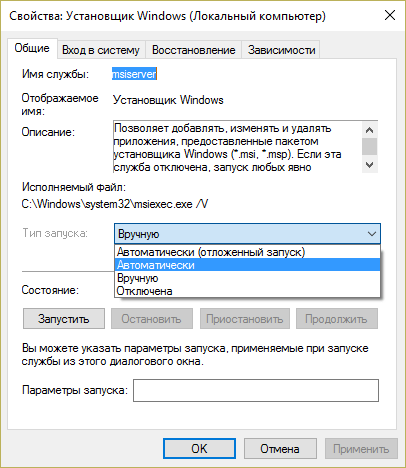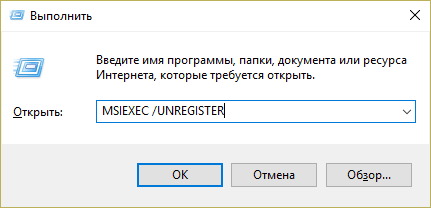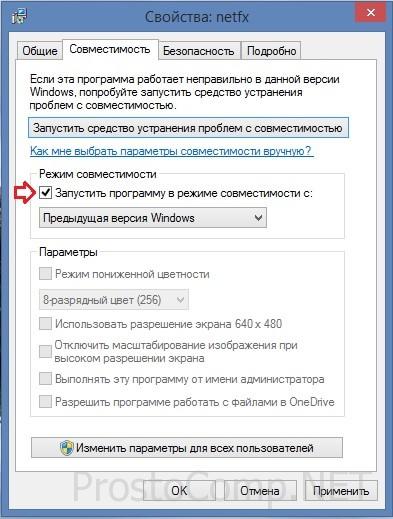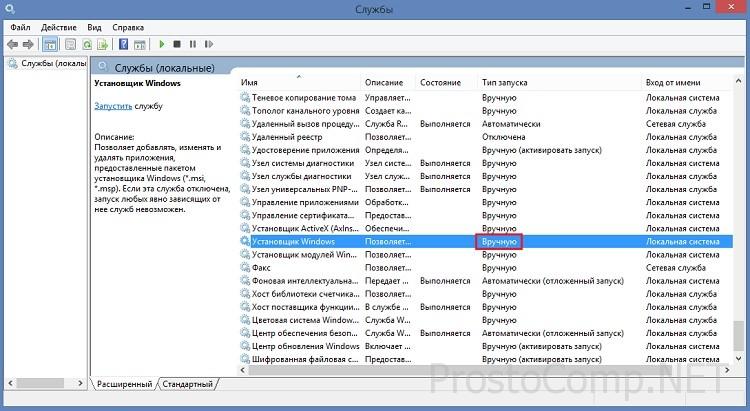Sometimes, during the installation of a program, an error code 1719 may appear on the screen, which indicates that the Windows Installer service is unavailable. There may be several reasons for this problem. Let's understand them and try to solve them.
Windows 7, 8, 10 installer service is unavailable or not responding
Scan system files
So, when you see a similar message on the screen, you should immediately scan your system files. To run the scanning tool, you must run the command prompt as an administrator, click Start on the desktop - enter cmd in the search, click on the corresponding icon command line right-click and select - Run with administrator rights. In the command line window that opens, enter the task sfc/scannow and click Enter. Once the check is completed, your problem may be resolved.
Availability of windows installer
Open Start - Run. In the window that opens, enter the task services.msc.
In the new window, find the Windows Installer item.

Double click on the icon. In the window, find the Startup type parameter and make sure that Automatic or Manual is selected next to it. After that, select Run and click OK. Next, you need to restart your computer for the changes to take effect and try to reinstall the required program.

You can also run the installer via the Command Line. In it you need to write net start MSIServer and click Enter. After this, you will see a corresponding notification that the service is running.
Deleting and re-registering a service
If after the above machinations the error still occurs, try re-registering the installer. This can be done in two ways: using the Command Line and using the Run service.
Let's consider the first option. Check which version of the operating system is installed on your computer, 32-bit or 64-bit. To do this, go to My Computer and right-click on an empty space. Select Properties. In the pop-up window you will find the required information.
Log in to the Command Prompt as an administrator (how to do this is described above). For a 32-bit system, type the command msiexec /unregister, which will deactivate the installer. Click Enter and then type msiexec /register which will log it back into the system.
If your system is 64-bit, then the commands will be as follows:
%windir%\system32\ msiexec.exe /unregister
%windir%\system32\ msiexec.exe /regserver
%windir%\system64\ msiexec.exe /unregister
%windir%\system64\ msiexec.exe /regserver
After this, reboot the machine.
The second option involves using the Run service, which can be opened through the Start menu. At the prompt, type msiexec /unregister and click OK. Then type msiexec /regserver. Don't worry if you don't see any changes on the screen. Your problem should, however, disappear after this.

Registry changes
A more radical method is to change settings in the registry. In the Run service we enter regedit command. A Registry Editor window will open. In it you need to follow the branch:
HKEY_LOCAL_MACHINE\SYSTEM\CurrentControlSet\services\msiserver
Find ImagePath and make sure its value matches the following: %systemroot%\system32\msiexec.exe /V. If the indicator is different, double-click the left mouse button on the name of the item and enter the required parameters in the window that appears. After this, you need to start the services.msc service as described.

Hello. Today I want to raise a topic that has become sore. I don't know about you, but I'm Lately I often encounter problems at work Windows installer– errors msi. Moreover, this issue can be relevant both for the good old Windows XP and for the relatively “fresh” Windows 7 and Windows 8. Let’s look at this issue in detail, since the topic is very serious and if the problem arose once, then believe me, it will last a lifetime It will definitely complicate things.
What kind of files are these that have the msi extension?
This installation package file, which is used to install software, and which uses the Windows Installer service. Own extension name msi took from " Microsoft Installer» , as the Windows Installer version used to be called. Such a file contains a complete installation script for the software product, auxiliary components, libraries and, in most cases, all installation files compressed into cab archives. You can discuss for a long time all the advantages and disadvantages of work Windows Installer, but we will still have to accept it “as is”, and we will respond competently and adequately to some problems in the work. Errors can occur both in the operation of the service and due to the msi files.
This is what sometimes happens: and then the system asks me to verify whether there really was an installer file that I ran. At first it sounds at least strange. But, reading further the system message, I understand that I am being asked to verify not only the presence of the file itself, but also my rights to access it. As it turned out, it was not me, but Windows Installer was denied access to the file, hence the problem.
This issue is not resolved in a complicated way. Let's first make sure whether the system has full access to the file, for which in the “Properties” of the file, go to the “Security” tab and find the user “System”.
 I’m more than sure that you won’t find it there, so add it yourself - click on “Change”, then on “Add” and enter the name: “System” (or System, in the case English version systems),
I’m more than sure that you won’t find it there, so add it yourself - click on “Change”, then on “Add” and enter the name: “System” (or System, in the case English version systems),

then click on “Check names” (the line becomes underlined).
Confirm – OK and check the “Full access” checkbox, confirm again.
Click on “Advanced”, then – “Change permissions” – “Add permissions” »,
inherited from parent objects and we confirm everything three times.
Thus, we got rid of this installer error, and it will no longer bother us during the installation process. Although it would be more reasonable and prudent to add full system access rights to the entire content folder from which the software is usually installed (as in my case, the “Install” folder).
If your computer has operating system Windows XP, and in “Folder Options” “simple general access to files", you will not see the "Security" tab in the file properties. In this case, you should go to “Folder Options” and uncheck the “Use simple file sharing” checkbox. Also, you risk not finding this tab in different “builds” and “lite versions” of both Windows XP and Windows 7. To access this tab, you will have to boot into Safe mode ( Safe Mode) and enter under account administrator.
Another problem with Windows Installer can be avoided by running the installation of applications with the antivirus program disabled, with administrator rights, and also in compatibility mode (the “Compatibility” tab in the properties of the msi file, check the corresponding checkbox).
 There may also be problems when trying to install the program from removable media, a flash drive, for example (such actions can be prohibited in the operating system settings) - just copy the installation file to a convenient location on your hard drive. Another option to solve the problem is to create a new folder under any name you like and copy the installation package into it, from there and start the installation - it can be useful for errors number 1603, 214 728 7035, 2203 and 1723.
There may also be problems when trying to install the program from removable media, a flash drive, for example (such actions can be prohibited in the operating system settings) - just copy the installation file to a convenient location on your hard drive. Another option to solve the problem is to create a new folder under any name you like and copy the installation package into it, from there and start the installation - it can be useful for errors number 1603, 214 728 7035, 2203 and 1723.
Be sure to ensure that the system has access to the temporary file directories. Open System Properties (Win+Pause or context menu right-click on the My Computer icon, select the Properties line), in “ Additional options systems",
 On the "Advanced" tab, click on the "Environment Variables" button.
On the "Advanced" tab, click on the "Environment Variables" button.
 We find the folders of temporary variables (they have the words TEMP, TMP in their names), check whether the system has access to them (using the algorithm already described above). I hope you remember, to find out the address of such a folder, you need to double-click on the variable
We find the folders of temporary variables (they have the words TEMP, TMP in their names), check whether the system has access to them (using the algorithm already described above). I hope you remember, to find out the address of such a folder, you need to double-click on the variable
 and, having copied the specified path, paste the contents of the clipboard into the Explorer line and navigate to the folder. And at the same time, you can do something useful - clear all temporary folders from their contents.
and, having copied the specified path, paste the contents of the clipboard into the Explorer line and navigate to the folder. And at the same time, you can do something useful - clear all temporary folders from their contents.
 It would also be the right decision to check for access rights those directories in which you plan to install applications and a directory named Config.
Msi fundamentally system partition. Encryption must be disabled for all the directories indicated above, since the Windows Installer in this case does not have access to them, unlike the user.
It would also be the right decision to check for access rights those directories in which you plan to install applications and a directory named Config.
Msi fundamentally system partition. Encryption must be disabled for all the directories indicated above, since the Windows Installer in this case does not have access to them, unlike the user.
Well, of course, an installation error may occur due to a corrupted installation file (the so-called “broken” file, with a checksum mismatch), in such a situation it is necessary to get hold of a known “working” normal installation file. Most likely, it will make sense to download it from another source or through another mirror.
Cause of Windows Installer Error
Now it’s worth considering a situation where installation of an application is impossible due to errors in the Windows Installer itself. If the installation process does not start, no matter what application you try to install, then most likely the problem is in the installer service itself. System error messages may appear containing phrases such as: Installer package or Windows error Installer Error. The reason for this may be either errors in the system registry or a virus attack. Let's start with checking the status Windows services Installer and its launch type. For this purpose, in the Run line (Win + R) we enter the command services. msc, and in the console that opens we find the item we are looking for - “Windows Installer”.
 Let's see if it works and what its startup type is (must be set to Manual). If the service does not work and has a different startup type, then start it (click “Run”, you can click “Restart”), and change the startup type in the properties to "Manual". If the service is started, check the situation and enter the command in the “Run” line msiexec– if everything is OK, then instead of an error you will see a window with the Windows Installer launch parameters and its version number.
Let's see if it works and what its startup type is (must be set to Manual). If the service does not work and has a different startup type, then start it (click “Run”, you can click “Restart”), and change the startup type in the properties to "Manual". If the service is started, check the situation and enter the command in the “Run” line msiexec– if everything is OK, then instead of an error you will see a window with the Windows Installer launch parameters and its version number.
I see further elimination of the problem in correcting the damaged system files operating system. To implement this, in the “Run” line, execute the command sfc/ scannow(prepare in advance the disk from which your operating system was installed, it may be needed in this process) and then reboot the computer. In theory, the problem should disappear.
Also this problem appears on the Microsoft website with a solution. Follow this link and launch the native FixIt utility. Follow the instructions provided, this should help resolve the issue.
Another option to eliminate this scourge may be to try to restore the registry settings for the Windows Installer, under which everything works normally. Run the registry editor file from the archive here and confirm the import of new settings (do not forget to change the settings in the registry before
During normal installation program, some users are “fortunate” to encounter a system message about problems in the operation of the Windows installer: it seems that access to it is impossible, such a service is not connected, or, in principle, such software is not available in the system. Not much pleasant, right? But is there a chance to get rid of this “gift” without? The question is not an easy one. However, if you want to revive windows installer V Windows system 7 can be done using these step-by-step instructions.
Step #1: Check for Service Availability
In the event that the Windows installer for some reason does not work, before complaining about your difficult fate, you need to clarify whether such a program is in principle available on the computer. How to do it? Just select on the keyboard and R then, in the window that appears, enter the value msiexec and click OK:

As a result, if Windows Installer is installed on the computer, a system notification window similar to this will appear:

If a miracle does not happen (for example, an error message appears or about the absence of such a program in Windows 7), you can immediately jump to step No. 5, since a simple reconfiguration will not do. This happens rarely, but still. If everything is fine, the window appears as it should, we move on and try to revive the Windows installer on our own.
Step #2: Trying to start the service
Having established that Windows Installer is on the computer, you need to clarify whether this service is enabled on the system or not. How to do it? To get started, choose one of the following options:
One way or another, the result of such actions will be the appearance of the “Services” window on the screen. In it we find the “Windows Installer” item, click on it with the mouse and check the data indicated opposite it in the “Status” column. What will indicate its performance? The value is "Working". If the column is empty, then most likely the service is not running. In this case, in the upper left corner we find the corresponding button (“Run”) and execute Windows launch Installer:

If the “Status” column indicates that the installer is running, although this is not at all true, you can try to restart this service by clicking the corresponding item in the upper left corner. After this, all that remains is to restart the computer and test the functionality of the Windows Installer. If after such settings the program returns to normal, we can congratulate ourselves, the “torment” is over. Otherwise, you will have to “step” further.
Step #3: Re-registering the service via the command line
You can return the Windows installer on 7 to normal operation by re-registering such a service in the system. How do we act?
Go to the Start menu, enter cmd in the search box and press Enter. Next, enter the msiexec /unregister parameter into the console that appears, press Enter, and then after the command line responds, enter the msiexec /register value into it and press Enter again:

We repeat entering the commands if we are dealing with 64-bit Windows 7, and then reboot the computer. In principle, this is where all the difficulties with Windows Installer often end. However, if the working atmosphere for the Windows installer has not returned after this, before reinstalling it, you can try to revive it through the registry editor. But what if?
Step #4: Debugging via Registry Editor
You can try to resurrect Windows Installer through the registry editor in this way:

and delete all existing parameters in them:

If there is no data in the destination folders, right-click on the Installer folder, and then click “Permissions” in the list that appears. Next, in the window that opens, click System, check the “Full Control” option and click OK:





